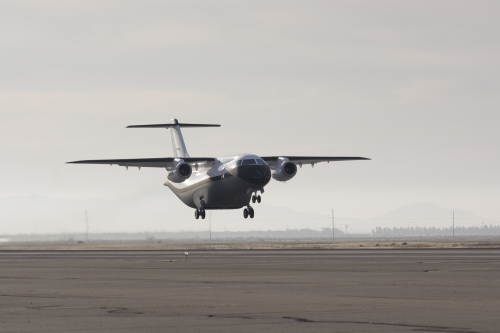
The ACCA is a proof of concept technology demonstrator for composite manufacturing processes in a full-scale, certified aircraft.
The ACCA is a modified Dornier 328J aircraft. The fuselage aft of the crew station and the vertical tail were removed and replaced with new structural designs made of advanced composite materials. The modified fuselage has enlarged rear cargo doors and can accommodate two standard size military pallets.
The ACCA's large composite sections are essentially formed, cured and bonded together in room-sized ovens, instead of using expensive autoclaves. This out-of-autoclave curing of large, unitised and co-bonded structures minimises part count.
Despite its larger size, the materials and processes used for the fuselage reduced the number of parts by an order of magnitude relative to the original metal design (approximately 300 versus 3000) and greatly reduced the number of mechanical fasteners (about 4000 versus 30 000), programme officials say.
The flight marks the final milestone of Phase II of the Air Force Research Laboratory (AFRL) ACCA programme.
"This has the potential to change aircraft manufacturing as we presently know it, for the better," says Barth Shenk, ACCA programme manager from AFRL's Air Vehicles Directorate at Wright-Patterson Air Force Base. "Today's successful flight is the culmination of years of teamwork between government and industry labs involving hundreds of dedicated researchers across the country to fundamentally change the way we make airframes."
The new composite structure is manufactured without complex tooling and the bonding process yields a 90% reduction of structural components and fasteners, according to Frank Mauro, vice president of Advanced System Development, Lockheed Martin.
"Historically aircraft cost has been generally determined by the size and weight of the vehicle," Mauro says. "With ACCA we are proving that while size does matter, it isn't the be-all, end-all determination of aircraft cost."
Lacking traditional fasteners like rivets, the composite structure is inherently aerodynamic. Shenk believes composite structures will address many of the corrosion and aging issues associated with all-metal aircraft, reducing airframe lifetime maintenance. Lighter weight of composite materials can also contribute to increased cargo capacity, aircraft performance and lower operating costs. The real 'game changer', however, is the maturation of manufacturing processes which collectively dramatically reduce the cost and complexity of building large airframes.
The ACCA's first flight was made possible by a 10-year AFRL-led research and development investment called the Composite Affordability Initiative.
The ACCA test aircraft is laden with more than 600 sensors and accelerometers to measure stresses on its structure. Upcoming tests will focus on establishing the flight envelope of the ACCA to baseline its flight performance and validate predicted structural performance.
"Accurately predicting structural behaviour in the flight environment is a key step in establishing the eligibility of the technologies for transition into future programmes, to fully realise the cost savings demonstrated by the ACCA," Shenk says.
| Watch a video clip of the ACCA's first flight. |





